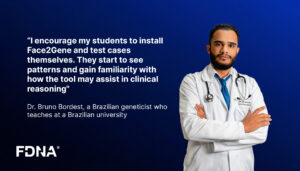May 22, 2016
S. Douzgou, S. Banka
Abstract
Developments in technology led to an increased understanding of the genetic basis of Chromatin Disorders, a group of developmental disorders caused by disruption of chromatin remodeling (DDCRs). We used Facial Dysmorphology Analysis technology (FDNA®) to objectively evaluate the craniofacial dysmorphic features of DDCRs. We propose that a condition should be recognizable by gestalt if it fulfills the following criteria: (i) the ‘syndromic face’ is significantly different from the average, general population face (denoted as ‘severity’); (ii) the syndromic face is significantly different from typical faces of other syndromes (denoted as ‘distinctiveness’); (iii) the variability between faces of patients with the same syndromic diagnosis is minimal.
As variability is difficult to assess without knowing the full spectrum of the conditions, we focused our analysis on the severity and distinctiveness of DDCRs by using published, 2D facial photographs of patients with 20 distinct, molecularly confirmed DDCRs to create a common ‘facial photo crop’ for DDCRs. This was proven to be distinct to the ‘average, normal face’. To evaluate the severity and distinctiveness of the DDCR faces, we compared each of the 20 syndromes’ facial photo crops (n=5) to 1) other syndromes in the DDCR group (19 syndromes); 2) other dysmorphic syndromes not in the DDCR group (100 other syndromes); 3) normal (1000 photographs). Methods included the mean area under the curve (AUC) to compare between samples and ROC curve plotting the true positive rate as function of false positive rates. We report the results of this analysis and discuss its implications.


